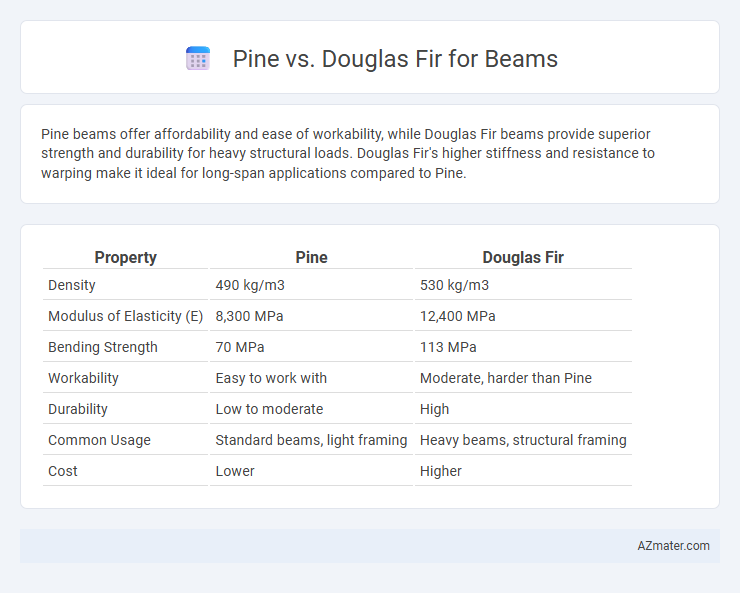Pine beams offer affordability and ease of workability, while Douglas Fir beams provide superior strength and durability for heavy structural loads. Douglas Fir's higher stiffness and resistance to warping make it ideal for long-span applications compared to Pine.
Table of Comparison
| Property | Pine | Douglas Fir |
|---|---|---|
| Density | 490 kg/m3 | 530 kg/m3 |
| Modulus of Elasticity (E) | 8,300 MPa | 12,400 MPa |
| Bending Strength | 70 MPa | 113 MPa |
| Workability | Easy to work with | Moderate, harder than Pine |
| Durability | Low to moderate | High |
| Common Usage | Standard beams, light framing | Heavy beams, structural framing |
| Cost | Lower | Higher |
Introduction to Pine and Douglas Fir Beams
Pine beams, known for their lightweight yet strong properties, are commonly used in residential construction for framing and support structures. Douglas Fir beams exhibit superior strength and durability, making them ideal for heavy-load applications and long-span beams in commercial and industrial projects. Selecting between Pine and Douglas Fir beams depends on load requirements, environmental conditions, and cost considerations, with Douglas Fir often preferred for its higher stiffness and resistance to decay.
Wood Properties: Pine vs Douglas Fir
Douglas Fir offers superior strength and stiffness compared to Pine, making it a preferred choice for load-bearing beams in construction. Pine wood is generally lighter and softer, with lower density and mechanical properties, which affects its durability and resistance to bending under stress. The higher modulus of elasticity and shear strength of Douglas Fir contribute to enhanced structural performance and longevity in beam applications.
Strength and Durability Comparison
Douglas Fir exhibits superior strength and durability compared to Pine, making it a preferred choice for structural beams in construction. Its higher density and tighter grain structure contribute to greater load-bearing capacity and resistance to wear, flex, and compression. Pine beams are generally softer and less durable, suitable for lighter loads and non-critical structural applications.
Weight and Load-Bearing Capacity
Douglas fir beams offer superior load-bearing capacity compared to pine, making them ideal for structural applications requiring high strength and durability. Despite being slightly heavier, Douglas fir's density ranges from 530 to 660 kg/m3, providing robust resistance to bending and shear forces. In contrast, pine weighs between 350 to 560 kg/m3, which results in lower load capacity but lighter overall weight, suitable for less demanding structural uses.
Workability and Ease of Installation
Pine beams offer excellent workability due to their softer texture, allowing for easier cutting, nailing, and shaping compared to Douglas Fir. Douglas Fir is denser and harder, requiring more effort and specialized tools for installation but provides superior durability in the long term. Both woods are widely used, yet Pine's ease of handling often makes it the preferred choice for quick, efficient beam installation projects.
Cost Differences and Budget Considerations
Pine beams generally present a lower initial cost compared to Douglas fir, making them a budget-friendly choice for many construction projects. Douglas fir offers superior strength and durability, which can justify its higher price through long-term performance and reduced maintenance expenses. When budgeting, consider both material cost and the lifespan of the beam to determine the most cost-effective option for structural needs.
Appearance and Grain Aesthetics
Douglas Fir beams showcase a distinct, pronounced grain with rich amber to reddish hues, offering a bold and elegant aesthetic ideal for rustic or modern interiors. Pine beams present a lighter, softer appearance with a more subtle grain pattern and pale yellow to light brown tones, providing a warm, inviting ambiance. Both woods enhance structural and decorative applications, but Douglas Fir's tighter grain and deeper color typically appeal more to those seeking strong visual impact.
Resistance to Decay and Insects
Douglas Fir beams exhibit superior resistance to decay and insect damage compared to Pine, making them more durable in outdoor and high-moisture environments. The natural density and tighter grain of Douglas Fir enhance its ability to withstand fungal attacks and termite infestations. Pine, while more affordable, is generally less resistant and often requires chemical treatment to improve its durability against decay and insect activity.
Sustainability and Environmental Impact
Douglas Fir beams are often favored for their strength-to-weight ratio and faster growth cycles, promoting sustainable forestry practices and reducing environmental impact. Pine beams, particularly from sustainably managed plantations, offer carbon sequestration benefits and lower embodied energy, driving eco-friendly construction choices. Both woods contribute to sustainable building, but Douglas Fir's resilience and renewable sourcing often make it the preferred option for environmentally conscious projects.
Best Applications for Pine and Douglas Fir Beams
Pine beams are best suited for interior applications such as residential framing, furniture, and decorative accents due to their lightweight nature and ease of machining. Douglas Fir beams excel in structural uses requiring high strength and durability, including heavy timber construction, bridges, and commercial buildings because of their superior load-bearing capacity and resistance to deformation. Both species offer versatility, but selecting Pine or Douglas Fir depends on balancing aesthetic preferences with structural demands.

Infographic: Pine vs Douglas Fir for Beam
 azmater.com
azmater.com